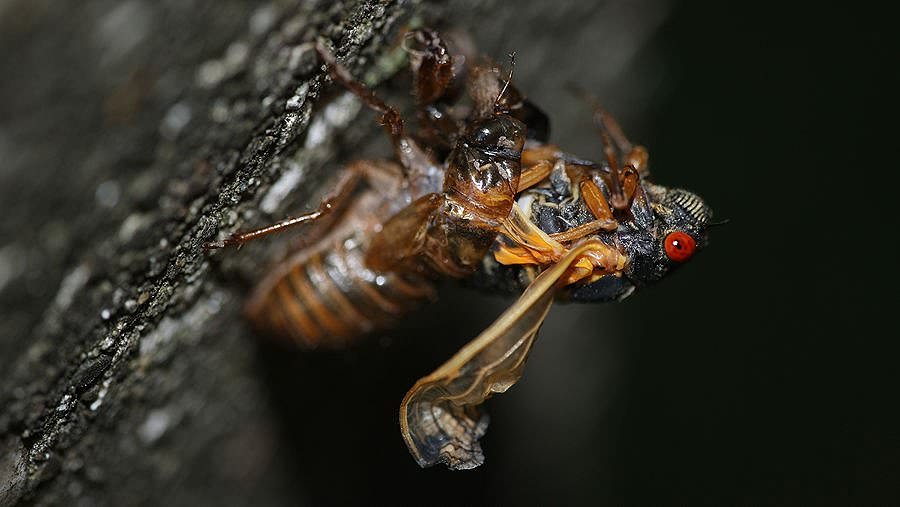Enormous red-eyed cicadas are set to swarm a dozen states this spring for a sex-filled rampage after emerging for the first time in 17 years.
Trillions of Brood XIV cicadas, the second-largest kind of the eerie-looking insect, are creeping up from their underground hideouts with the sole purpose of mating before they croak.
There are more than 3,000 species of cicadas that form 15 periodical broods – known as Magicicada – that pop up across eastern North America.
Broods do not refer to a specific species, moreso a group that emerges at the same time.
Three of those broods are on 13-year cycles and 12 that spawn on 17-year cycles, according to the US Forest Service. They differ from annual cicadas, which appear every summer.
While burrowing underground, the nymphs simply eat and grow until it is finally their time to shine, digging holes to make their way to the surface.
Brood XIV cicadas are the group that all other Magicicada stemmed from over the past 10,000 years, Senior Research Scientist and cicada expert Dr. Chris Simon of UConn told DailyMail.com.
In fact, they were the very first brood to be written about by colonists in the New World, Simon said.
The influx of these mother-of-all periodic cicadas is set to hit several states in mid-May, but sightings of this brood have been reported since mid-to-late April.
These approximately one and three-quarters big bugs were first spotted in North Carolina and Tennessee, according to reports through the Cicada Safari app, developed by Dr. Gene Kritsky, an entomologist at Mount St. Joseph University in Ohio.
Cicada Safari was developed for keen insect observers to document where they see periodically-appearing cicadas.
According to Cicada Mania, a website also created by Kritsky, Georgia, Indiana, Massachusetts, New Jersey, New York, Ohio, Pennsylvania, Tennessee, Virginia and West Virginia are the states that have to brace for the great cicada come-back.
Although the black and orange bug may look intimidating to those with insect aversions, they are no threat at all, Simon assured.
‘They are harmless, they don’t bite or sting,’ she wrote to DailyMail.com.
She said they can only damage small trees by laying eggs, but this can be addressed by placing nets over weak-branched saplings.
The non-dangerous insects are at the very least annoying to some cicada critics, as the bugs have to sing to mate, creating a distinct buzzing sound that rings through spring and summer nights.
Male cicadas of all three groups of Magicicada – decula, cassini and decim – sing different tunes to lure in prospective partners four or five days after surfacing, Simons explained.
Two or three weeks into above-ground living, cicada couples get to mating in trees before females lay eggs in the third and fourth weeks.
Cicadas only live for about four to six weeks above ground, meaning they die shortly after they mate – leaving behind eggs of cicadas expected to repeat the cycle in 2042.
However, a genital-destroying fungus that has plagued every brood population has ramped up cicadas’ sex drives and turned them into ‘zombies.’
‘It is generally prevalent in every brood (five to 10 percent of the population or more) but is mainly obvious in the last two weeks of the emergence,’ Simon explained.
Massospora cicadina, a deadly fungus that only targets periodical cicadas, essentially replaces the insects’ genitals with a block of fungus.
It consumes the creature’s abdomen, genitals and buttocks – replacing them with fungal spores.
Once the fungus is in charge, it directs the infected male to perform the female mating ritual by flicking its wings, attracting other males and spreading the infection like an STD.
‘It is quite ingenious and technically is a sexually transmitted disease,’ Smithsonian Entomologist and Collections Manager Floyd Shockley previously told the DailyMail.com.
Cathinone, a stimulant found in the fungus, is known to hyper-sexualize cicadas.
‘It’s sex, drugs and zombies,’ John Cooley, an evolutionary biologist at the University of Connecticut told Scientific American about the bizarre and unsettling fungus.
‘Nature is stranger than any science fiction that’s ever been written.’
The infection begins as the nymphs make their journey to the surface, climbing through spores in the ground.
‘While males and females can be infected equally, the fungus produces a hallucinogenic compound that results in a change in infected males,’ said Shockley.
‘They are thrown into a sexual overdrive and respond to mating calls of males and will flick their wings like females receptive to mating.
‘By doing so, they can infect males and females alike…and they are tricked into doing so as much as they can for as long as they can before they ultimately succumb to the fungus and die.’
This year’s invasion should not be as bad as last year’s, when a trillions of the red-eyed bugs infested the nation in a 200-year event known as the cicada ‘apocalypse’.
For the first time since the 19th century, two different broods of cicada emerged across more than a dozen states, mating and laying millions more eggs.
The groups were 17-year Brood XIII and 13-year Brood XIX, also known as the Great Southern Brood, which is the largest of them all.
Kritsky told DailyMail.com at the time: ‘The dual emergence is a one in two or three lifetime event.
‘This happens 12 times every 221 years, but this is the first time since 1803 that these broods will emerge together.’
